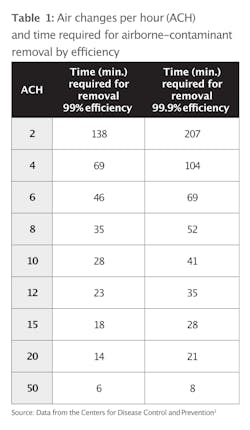Everything you need to know about indoor air quality in a dental setting
The current COVID-19 pandemic has brought indoor air quality into the spotlight, as dental professionals have been extremely affected by closedown mandates and reopen procedures. National organizations—such as the Centers for Disease Control and Prevention (CDC), the American Dental Association (ADA), and the Occupational Safety and Health Administration (OSHA)—have established multiple guidelines for reopening; however, none is clear on what business owners should do about their indoor air. For dental offices, it means more than just filtering the air. Guidelines must also address the concern for reducing the risk of transmission of aerosolized biologicals to protect patients and staff members.
The CDC recommends “the use of a portable, high-efficiency particulate air (HEPA) air filtration unit while the patient is undergoing, and immediately following, an aerosol-generating procedure” in a dental setting, as well as an understanding of clinical airflow patterns to determine air changes needed per hour.1 The guidelines are broad, and many dental professionals are wondering how they can make sure their patients and staff members feel safe enough to go back to the dental office.
Understanding air exchanges
Air exchange rate is defined as the amount of times the air in a particular enclosed space can be processed through a system. In a dental setting, aerosol droplets can come from various sources and procedures, including dental instrumentation, salivary and respiratory sources, ultrasonic scalers without a rubber dam, and air-water syringes.2 Because aerosols can stay in the air and travel farther than splash and spatter, distant contamination may occur. Further, there is the potential for disease transmission even after the infected person has left the office—hence, it is necessary to increase the number of air exchanges per hour in a room. On top of decreasing the risk of airborne infections, increasing the airflow also decreases patient turnover time and creates a positive public perception.
How to implement an indoor air-quality plan
After understanding the importance of increasing air exchanges, it is time to implement an indoor air-quality plan. In general, a heating, ventilation, and airPortable air purifiers are the most common and efficient solution to increase air exchanges in a dental office, but there are multiple options to choose from. Since having a HEPA filter is a CDC recommendation, we will focus on the different types of technologies available for the removal of odors and volatile organic compounds (VOCs).
The leading technologies on the market are:
- Ionizers: release electrically charged ions into the air to attract particles, which allows the ions to attach to the particles causing them to clump together and settle out of the air.
- Ozone generators: cause a chemical reaction with gaseous pollutants and do not work on particles. According to the American Society of Heating, Refrigerating and Air-Conditioning Engineers (ASHRAE), an ozone generator “should only be considered for disinfection on unoccupied spaces; it should never be used in occupied spaces.”4
- Carbon filters: carbon is very effective in removing odors and VOCs, but it is often treated with chemical additives to improve its efficiency, which can end up in the filtered air.
- Earth mineral technology: this patented technology by EnviroKlenz is composed of three earth minerals that capture and neutralize odors and VOCs without releasing any by-products back into the environment.
Whole room versus HVAC versus source capture
An HVAC system is a forced-air system often designated to an entire office space. An HVAC forces the air through a one-point system and sucks it out through different returns. This can pose a risk if there are aerosolized biologicals or contaminants, because now you are spreading them throughout the entire dental office. This can happen even with the higher-grade MERV-13 filter, since viruses can often pass through it and make their way into the ductwork. If you are not careful with your HVAC system, it can become a supplier or amplifier for these pathogens.
Meanwhile, a source capture system comes in handy when the risk of exposure or transmission is greater. For example, during treatment when a patient’s mouth is open for several hours, the risk of transmission is higher. The source capture system would make sense in that it can be placed above the source to capture and reduce the risk of transmission.
A whole-room air system provides protection for the entire room as it exchanges the air continuously. For example, if someone were to walk into your office and sneeze, you would have the ability to filter the air in that whole room.
Each system plays a very important role in dentistry, and it is up to you to choose the one that best fits your needs.
Is it worth the investment?
A recent ADA survey showed that 72% of patients are ready to go back to the dentist, 14% would be willing to go with assurance from the dental office or national authorities, and the remaining 14% are not comfortable returning at all.5 Due to concerns about COVID-19, dental professionals should be going above and beyond to make their patients feel safe and comfortable in their offices. Taking measures to ensure indoor air quality is a good way to start.
Whether you choose a whole room or source capture air purifier, consider it a long-term investment. Air purifiers need to be maintained, so paying attention to filter prices and durability, as well as warranty time for the machine itself, is essential. By increasing ventilation in each operatory, you will also be decreasing patient turnover time. This is a profitable return on investment in the long run.
When it comes to the safety of your staff, air purifiers do not only eliminate pathogens (such as viruses and bacteria), but also allergens, VOCs, and odors. One option, the EnviroKlenz Air System Plus, has been tested against pathogens. Results show that it eliminates 99.9% of viruses and bacteria in a test performed with a virus one-quarter the size of SARS-CoV-2.6 Good air quality has also been proven to increase performance and decrease absenteeism in the workplace, making it a great asset for your work environment.7
References
- Guidance for dental settings. Interim infection prevention and control guidance for dental settings during the coronavirus disease 2019. Centers for Disease Control and Prevention. National Center for Immunization and Respiratory Diseases (NCIRD), Division of Viral Diseases. Updated August 28, 2020. Accessed October 15, 2020. https://www.cdc.gov/coronavirus/2019-ncov/hcp/dental-settings.html
- Geisinger ML. Aerosols in the dental office: best practices for patient and practitioner safety. CE course. Dentalcare.com. April 27, 2020. Accessed October 15, 2020. https://www.dentalcare.com/en-us/professional-education/ce-courses/ce619/dental-procedures-associated-with-aerosols
- Appendix B. Air. Guidelines for environmental infection control in health-care facilities (2003). Airborne Contaminant Removal. Table B.1. Air changes/hour (ACH) and time required for airborne-contaminant removal by efficiency. Centers for Disease Control and Prevention. National Center for Emerging and Zoonotic Infectious Diseases (NCEZID), Division of Healthcare Quality Promotion (DHQP). July 22, 2019. Accessed October 15, 2020. https://www.cdc.gov/infectioncontrol/guidelines/environmental/appendix/air.html
- Filtration/disinfection. ASHRAE. Accessed October 15, 2020. https://www.ashrae.org/technical-resources/filtration-disinfection
- Schaale S. ADA consumer research study shows most patients comfortable with returning to dentist. California Dental Association. August 27, 2020. Accessed October 15, 2020. https://www.cda.org/Home/News-and-Events/Newsroom/Article-Details/ada-consumer-research-study-shows-most-patients-comfortable-with-returning-to-dentist
- EnviroKlenz testing, validation, and white papers. EnviroKlenz Air Purifiers. Accessed October 15, 2020. https://enviroklenzairpurifiers.com/testing/
- Wyon DP. The effects of indoor air quality on performance and productivity. Indoor Air. 2004;14 Suppl 7:92-101. doi:10.1111/j.1600-0668.2004.00278.x
About the Author
Leticia Menzzano
Leticia Menzzano is a graduate from the communications program at Florida Gulf Coast University. She is the communications director at Timilon Corporation and contributes to multiple publications on behalf of the company. Menzzano is one of the indoor air-quality experts at EnviroKlenz and can be reached at [email protected].



